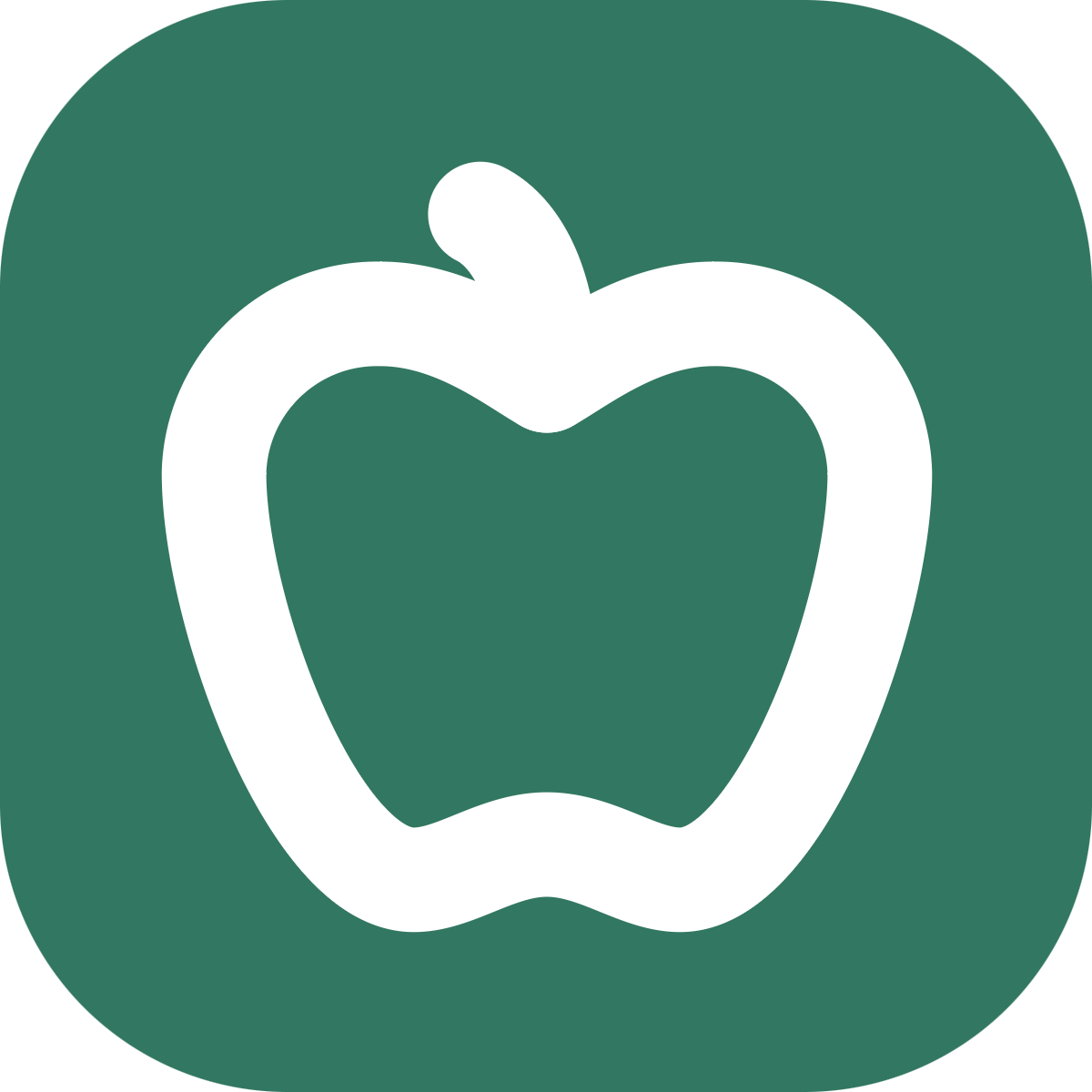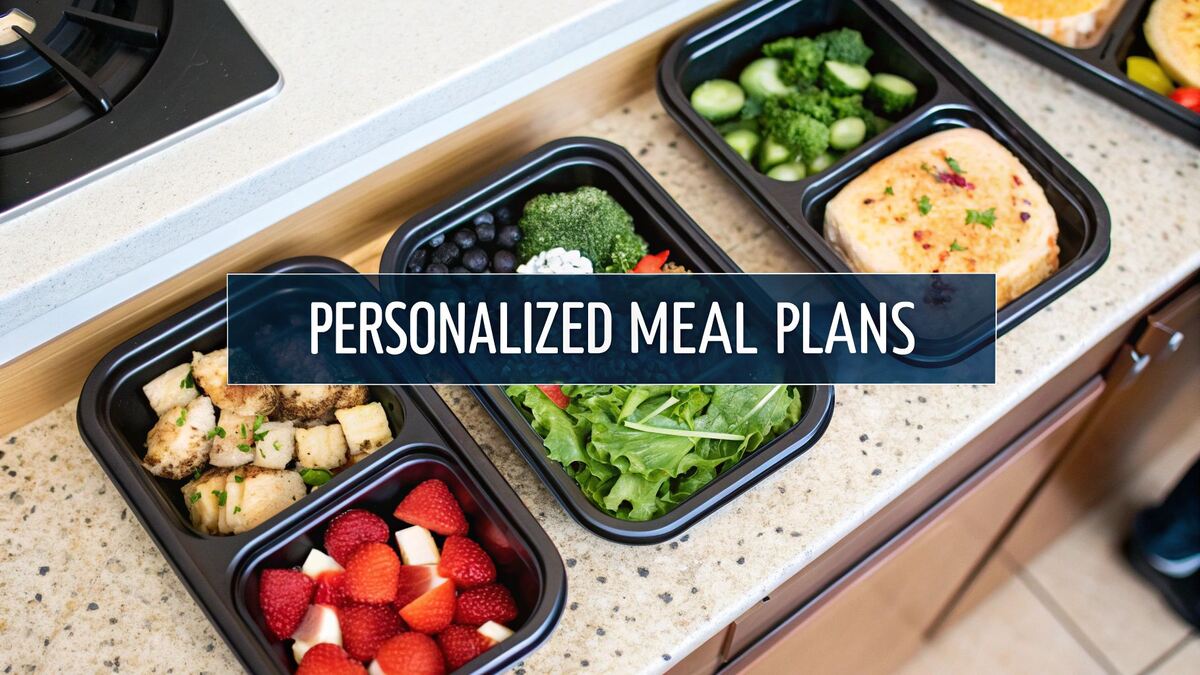Transform Your Body with Personalized Meal Plans for Weight Loss
A truly effective meal plan for weight loss isn't just a collection of recipes. It all starts with understanding your body's unique energy needs. The secret sauce is creating a small, sustainable caloric deficit—consuming slightly fewer calories than you burn each day. This is what turns a generic diet into a powerful plan built just for you.
Build Your Foundation for Sustainable Weight Loss
Before you even think about what to eat, you have to establish your personal nutritional blueprint. Generic, one-size-fits-all plans are doomed to fail because they completely ignore individual differences in metabolism, lifestyle, and body composition. To build something that actually works long-term, you need to figure out your specific energy requirements first.
This all comes down to your Total Daily Energy Expenditure (TDEE), which is the total number of calories your body burns in a 24-hour period. Think of it as your personal energy budget. It’s a combination of your resting metabolism and all the energy you expend moving around. Knowing this number gives you the perfect starting point for creating a smart, effective calorie deficit.
Calculate Your Daily Calorie Needs
So, what goes into your TDEE? It’s a mix of a few key factors unique to you:
- Basal Metabolic Rate (BMR): This is the baseline—the calories your body needs just to keep the lights on (think breathing, circulating blood, and cell production) if you were to lie in bed all day.
- Activity Level: This is a big one. It accounts for everything from your desk job and daily chores to intense gym sessions. The more you move, the higher your TDEE.
- Thermic Effect of Food (TEF): Yep, your body actually burns calories just digesting and absorbing the food you eat.
Once you have a good estimate of your TDEE, you can set a realistic weight loss goal. A healthy, manageable deficit is around 250-500 calories less than your maintenance number. This gentle approach promotes steady fat loss of about 0.5 to 1 pound per week without making you ravenously hungry or crashing your metabolism. A great first step is to find your BMI and ideal weight using an online tool, as this helps frame your overall goals.
Creating a personalized meal plan is less about restriction and more about precision. It's about giving your body exactly what it needs to thrive while gently guiding it toward your weight loss goals.
This infographic breaks down how all these pieces fit together.
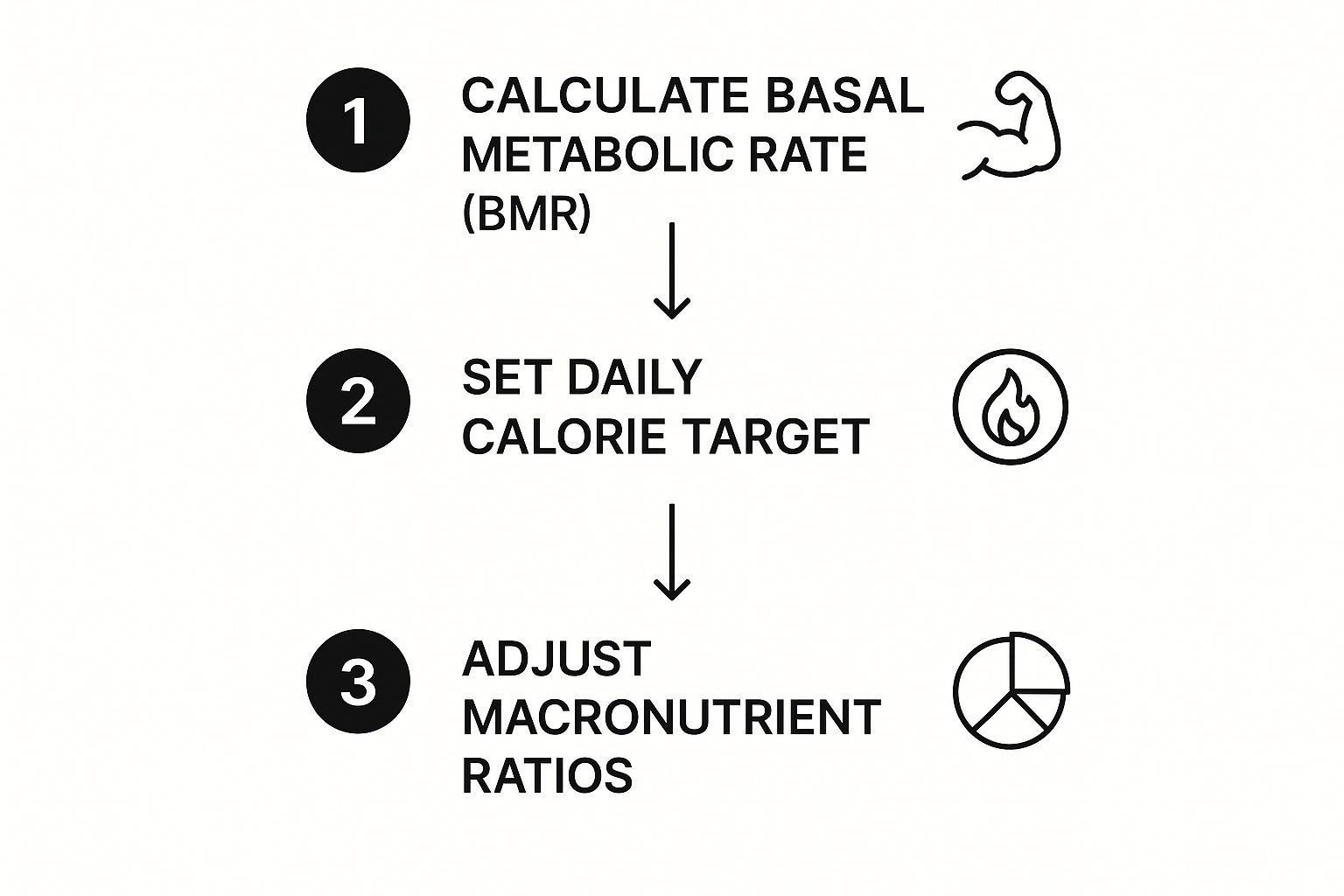
As you can see, it all starts with your personal numbers. Understanding your BMR and activity level helps you set an accurate calorie target, which then guides how you balance your macronutrients for the day.
To give you a better idea, here are some sample calorie targets. Remember, these are just estimates—your own calculation will give you a more precise number.
Example Daily Calorie Targets for Weight Loss
This table provides estimated daily calorie goals for weight loss based on different activity levels. Use this as a starting point before calculating your specific needs.
| Activity Level | Description | Estimated Daily Calorie Target |
|---|---|---|
| Sedentary | Little to no exercise, desk job | 1,300 - 1,500 calories |
| Lightly Active | Light exercise or sports 1-3 days/week | 1,500 - 1,700 calories |
| Moderately Active | Moderate exercise or sports 3-5 days/week | 1,700 - 1,900 calories |
| Very Active | Hard exercise or sports 6-7 days a week | 1,900 - 2,200 calories |
These figures illustrate how much activity can influence your energy needs. A personalized calculation will always be more accurate than a general chart.
Set Your Macronutrient Targets
But calories are only half the story. Where those calories come from—protein, carbs, and fats—is just as important for how you feel, your energy levels, and your results. Balancing your macronutrients (or "macros") ensures your body is getting the right kind of fuel.
Protein is your best friend during weight loss. It's crucial for preserving lean muscle, which keeps your metabolism humming. It’s also incredibly satiating, meaning it helps you feel full and satisfied, which is a game-changer for fighting off cravings. A good target for many people in a calorie deficit is 60-100 grams daily.
Carbohydrates are essential for energy. They fuel your brain and power your workouts, so cutting them out entirely often backfires. The trick is to focus on complex carbs from whole grains, vegetables, and legumes for slow-release energy and fiber.
Healthy fats are non-negotiable. They support hormone production and absorb certain vitamins. Think avocados, nuts, seeds, and olive oil—these are vital for a well-rounded diet.
Design an Eating Schedule That Fits Your Life
https://www.youtube.com/embed/HuP2BH4Y8PA
Okay, you've got your calorie and macro targets figured out. Now comes the fun part: deciding when you’re going to eat. This isn't about creating a rigid, minute-by-minute schedule that will make you miserable. It's about finding a natural eating rhythm that works with your body, not against it.
What works for your friend who’s a personal trainer might be a total disaster for you, an accountant who works long hours. A truly personalized meal plan for weight loss has to fit into your life—your job, your family, your social commitments. The goal here is sustainability, not a constant, stressful battle with the clock.
Finding Your Ideal Meal Frequency
There's no magic number of meals you "should" eat each day. I’ve seen clients succeed with all sorts of different approaches. The real key is to listen to your body and find what keeps your energy steady and your hunger in check.
Let’s look at a few common ways people structure their day:
- Three Square Meals: The classic breakfast, lunch, and dinner. It’s simple, familiar, and works great for people with a predictable 9-to-5. This structure can also help you be more mindful, since you have distinct times set aside just for eating.
- Five to Six Small Meals: This is my go-to for people who struggle with cravings or energy crashes. Eating a smaller meal or snack every 2-3 hours can help keep your blood sugar stable and prevent that ravenous hunger that leads to bad choices. Think breakfast, mid-morning snack, lunch, afternoon snack, and dinner.
- Intermittent Fasting (IF): This has become really popular, and for good reason. It’s less about what you eat and more about when. The 16/8 method is a common starting point: you fast for 16 hours and eat all your meals within an 8-hour window (say, from noon to 8 PM). Many people find it simplifies their day and helps them cut calories without even trying.
Remember, no matter which path you choose, your daily calorie and macro goals don't change. You're just slicing up the pie differently.
Syncing Your Plan with Real Life
A meal plan is just a piece of paper until it meets the chaos of a real week. A plan that can’t handle a busy Tuesday or a last-minute dinner invite is a plan that’s destined to fail.
Pull up your calendar. Where are the crunch times? When are your workouts? When do you have more breathing room? This is how you build a plan that can actually stick.
My best advice? Schedule your meal prep. Seriously, block out an hour or two on Sunday and treat it like a doctor's appointment. Cook a big batch of chicken, chop your veggies, and portion out some nuts. This one act will save you from so much stress and bad decisions during the week.
Think about your personal roadblocks. Do you always work late on Wednesdays? That’s the perfect night to have a healthy, pre-made dinner waiting for you. Have a weekly pizza night with the family? Plan for it! Look up the menu ahead of time and pick an option that fits your goals. Planning ahead means you can enjoy your life without the guilt.
Building a Flexible Template
Your schedule should be a guide, not a prison. I like to think of it as a flexible template—a default setting you can easily adjust when life throws you a curveball.
Here’s what that might look like for someone with a typical office job:
| Time | Monday (Work from Home) | Wednesday (In Office) | Saturday (Relaxed Day) |
|---|---|---|---|
| 8 AM | Protein Smoothie | Greek Yogurt with Berries | Scrambled Eggs & Avocado |
| 1 PM | Leftover Chicken & Quinoa | Prepped Salad with Salmon | Lunch Out with Family |
| 4 PM | Apple with Peanut Butter | Handful of Almonds | No Snack Needed |
| 7 PM | Homemade Turkey Chili | Quick Shrimp Stir-fry | Grilled Steak & Veggies |
See how the basic structure is there, but it adapts? On a busy office day, lunch is prepped and ready. On the weekend, there’s room for a meal out. This blend of consistency and flexibility is what makes a personalized meal plan for weight loss actually work in the long run.
Choose Foods You Genuinely Enjoy
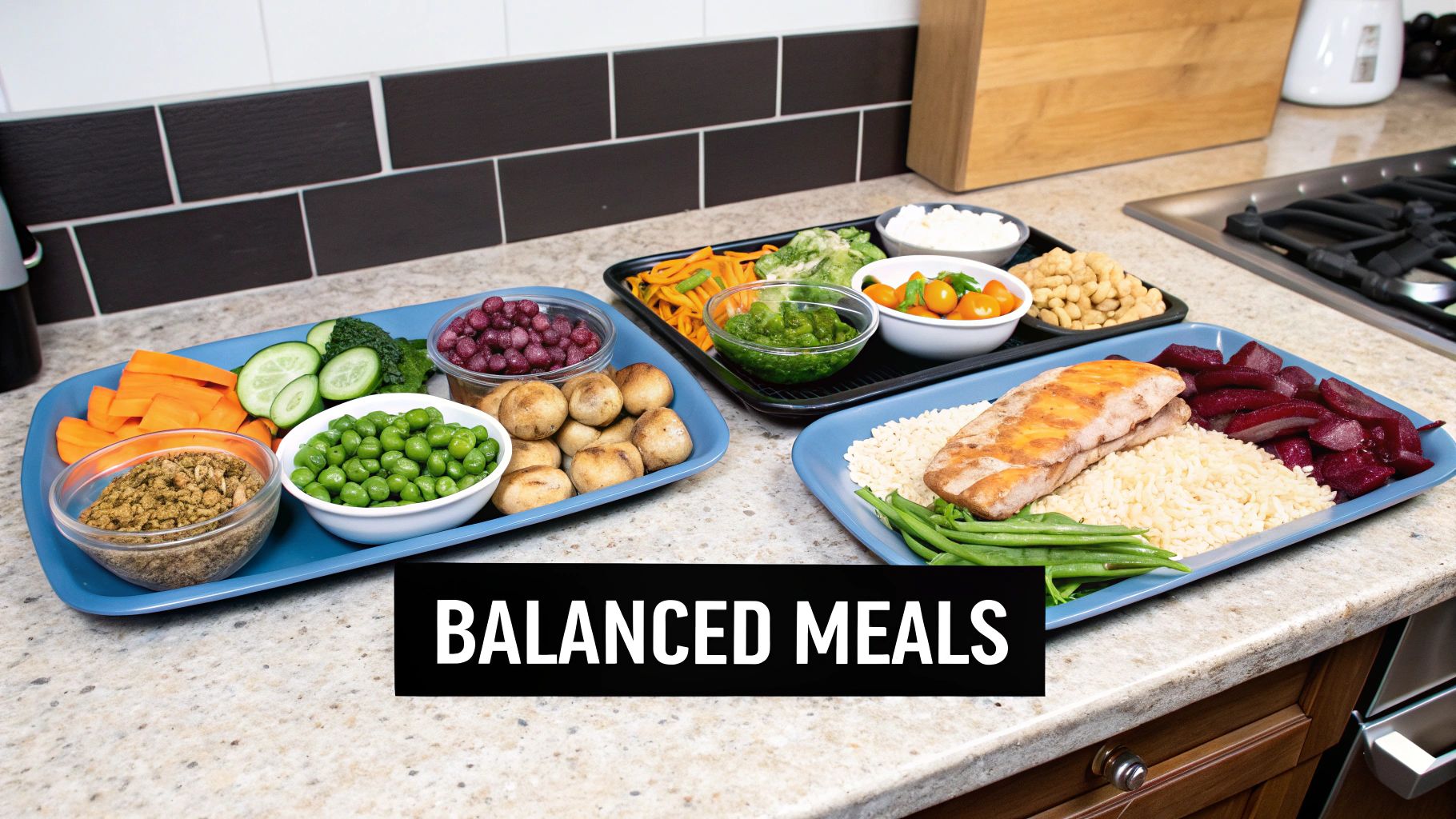
Alright, now for the best part—filling your plan with foods you actually want to eat. There's a huge myth that to lose weight, you have to choke down bland, boring meals. That mindset isn't just miserable; it's the fastest way to burn out and go right back to your old habits.
A truly personalized meal plan for weight loss has to be sustainable. If you’re already dreading your next meal, you won't stick with it for long. The real goal is to build a personal library of go-to foods that you love, but that also fit the calorie and macro targets you’ve set. It’s all about making smarter choices, not sacrifices.
Let’s shift our thinking from what you can't have to the incredible variety of delicious, nutrient-packed foods you can build your meals around.
Building Your Core Food Library
Your meal plan will come together from four main food groups. Your job is simple: pick your favorites from each. This isn't about sentencing yourself to a life of plain chicken and broccoli. It's about creating a solid rotation of options to keep things interesting.
Start by jotting down your favorite foods in these categories:
- Lean Proteins: These are the foundation. They’re crucial for preserving muscle while you lose fat and they keep you feeling full for hours. Think chicken breast, turkey, fish like salmon or tuna, eggs, Greek yogurt, tofu, and lentils.
- Complex Carbohydrates: Forget what you've heard—carbs are not the enemy. They’re your body’s main source of fuel. Just focus on high-fiber options that provide steady energy, like quinoa, brown rice, sweet potatoes, oats, and whole-grain bread.
- Healthy Fats: These are essential for hormone health and they add a ton of flavor and satisfaction to your meals. Good sources include avocado, nuts (almonds are great), seeds (like chia or flax), and of course, olive oil.
- Vibrant Vegetables & Fruits: This is where you can really load up. They're packed with vitamins, minerals, and fiber for very few calories. Go for leafy greens, bell peppers, broccoli, berries, and apples. The more color on your plate, the better.
A successful meal plan feels like an upgrade, not a punishment. When you build it with foods you love, you're not just following a diet—you're curating a healthier lifestyle that you actually want to live.
This approach gives you the freedom to mix and match things, creating tons of different meal combinations that never feel stale. For instance, a Mediterranean-style plan is famous for its incredible variety and health benefits. If that sounds good, you can explore some delicious Mediterranean meal plan options to see how those flavorful ingredients come together.
Making Smart Swaps Without Sacrificing Flavor
Little changes can make a massive difference without turning your food into cardboard. The trick is finding lower-calorie alternatives that give you a similar texture or flavor. This lets you enjoy the types of meals you love while staying on track.
Here are a few of my favorite swaps that really work:
| Instead of This... | Try This... | Why It Works |
|---|---|---|
| Sour Cream | Plain Greek Yogurt | Gives you that same creamy tang but with a huge protein boost and way less fat. |
| White Pasta | Spiralized Veggies or Chickpea Pasta | Slashes refined carbs while adding a good dose of fiber and nutrients. |
| Mayonnaise | Mashed Avocado or Hummus | Adds creaminess with healthy fats and fiber instead of empty calories. |
| Sugary Cereal | Oatmeal with Berries | Offers slow-releasing energy and fiber that will actually keep you full. |
| Creamy Salad Dressings | Olive Oil and Vinegar | You get a fresh, bright flavor without all the hidden sugars and unhealthy fats. |
These simple substitutions can easily shave hundreds of calories from your day, and honestly, you probably won't even notice the difference.
Don't Forget Hydration and Flavor
Finally, let's talk about the supporting cast: water and flavor. Staying hydrated is non-negotiable. It’s critical for your metabolism, and sometimes our brains mix up thirst signals with hunger cues. A glass of water can often stop you from needless snacking. Aim for at least eight glasses a day.
Flavor is what makes healthy eating enjoyable long-term. Salt, pepper, garlic powder, and other spices are your best friends—they add zero calories but a world of satisfaction. To really elevate your meals, try adding fresh herbs. You can even check out the easiest herbs to grow indoors for flavorful meals, like basil or mint. A little sprinkle of something fresh can take a simple dish from "just okay" to fantastic.
Let's See a Personalized Meal Plan in Action
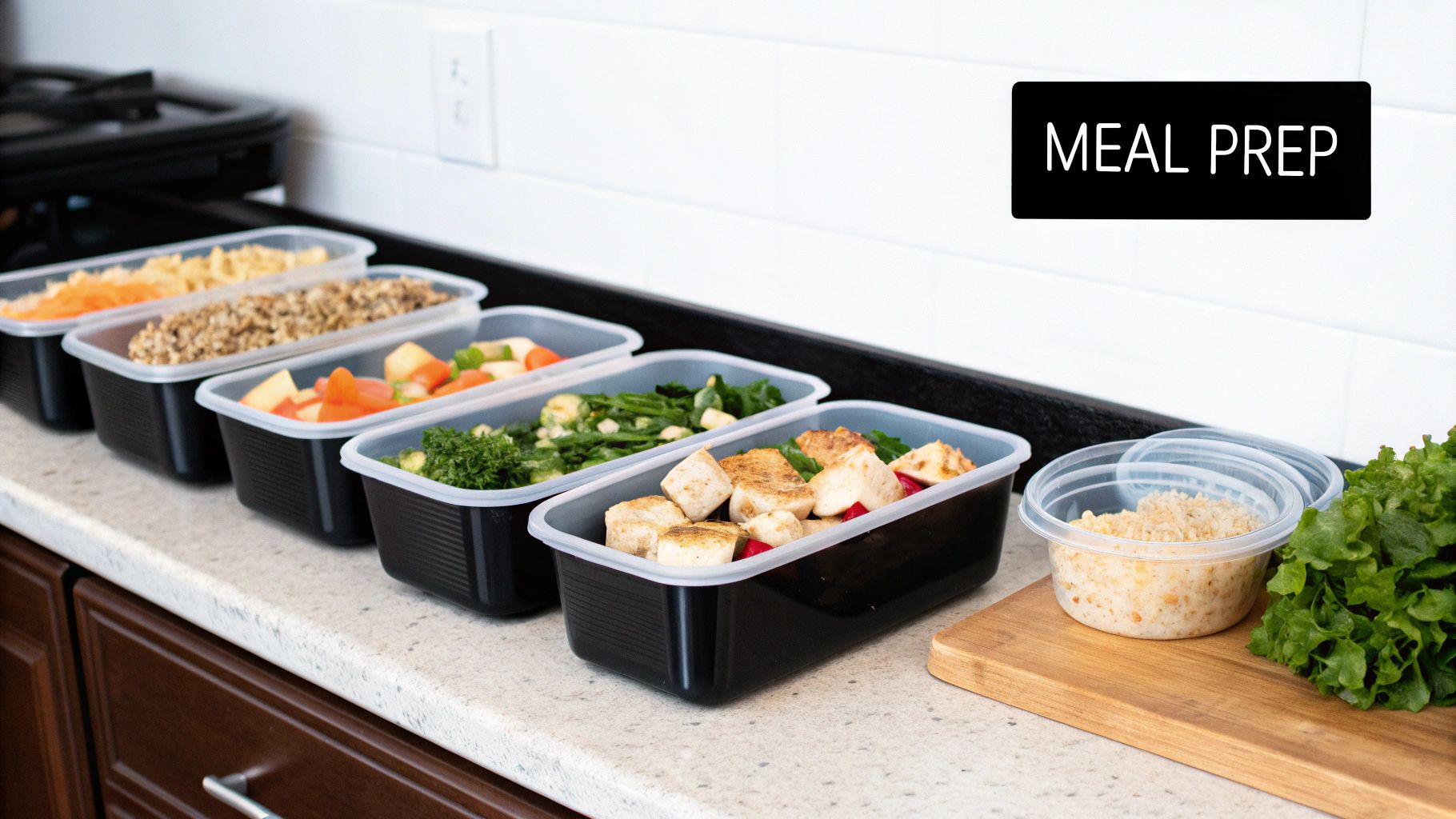
It’s one thing to talk about calories and macros in theory, but everything really clicks when you see how it all fits together in an actual day of eating. Let's walk through a real-world example to bring these concepts to life.
I want you to meet Sarah. She’s 35, works a pretty standard desk job, and hits the gym for a moderate workout about three times a week. Her goal is simple: steady, sustainable weight loss. With that in mind, we've set her daily target at 1,800 calories, making sure to prioritize high protein to support her workouts and, just as importantly, keep her feeling full.
A Powerful Start to the Day
Sarah kicks off her morning with a meal built for sustained energy. The goal here is to head off those classic mid-morning cravings before they even start. Trust me, a protein-heavy breakfast is an absolute game-changer for controlling your appetite all day long.
Breakfast (8:00 AM): Protein-Packed Scramble
- The Meal: She'll have 2 large eggs scrambled with a big handful (1/2 cup) of spinach and about 1/4 cup of diced bell peppers.
- On the Side: A single slice of whole-wheat toast topped with about 1/3 of a mashed avocado.
- The Numbers: This satisfying start comes in around 350 calories and provides a solid 20g of protein plus a good dose of fiber.
This mix of protein, healthy fats from the avocado, and complex carbs from the toast gives her a slow, steady release of energy. No 10 AM energy crash here. It just sets a strong, positive tone for the rest of her day.
A Smart and Satisfying Lunch
Come lunchtime, the mission is to eat a balanced meal that won't leave her feeling sleepy and sluggish for the afternoon grind. This is where a little meal prep can be your best friend, ensuring the healthy choice is also the easiest one.
Lunch (1:00 PM): Mediterranean Quinoa Bowl
- The Meal: A pre-prepped bowl with 1 cup of cooked quinoa, 4 oz of grilled chicken breast (cubed), a mix of cherry tomatoes and cucumber, and a tablespoon of feta cheese.
- The Dressing: Nothing complicated—just a simple mix of lemon juice and olive oil.
- The Numbers: This delicious bowl clocks in at roughly 450 calories and packs an impressive 35g of protein.
This is so much more than a boring desk salad. It's a nutrient-dense powerhouse that keeps her full and focused all afternoon. The fiber from the veggies and quinoa helps with digestion, while the lean chicken provides the crucial protein for muscle maintenance.
A truly great personalized meal plan never feels restrictive. It should feel empowering, giving you delicious, strategic options that work for your body—not against it.
The success of these kinds of structured plans is well-supported. For example, data from the Mayo Clinic Diet shows that members using their dietitian-designed personalized plans can lose 6 to 10 pounds in just the first two weeks. Over a longer period, this can lead to a significant body weight reduction of up to 13% after six months, which really highlights the impact of a tailored approach to eating.
Navigating the Post-Workout Period
Sarah usually hits the gym right after work, so her evening meal needs to be all about muscle recovery. This is a critical window to refuel your body with both protein and carbohydrates.
Dinner (7:00 PM): Salmon and Roasted Veggies
- The Meal: A 5 oz baked salmon fillet seasoned with herbs.
- On the Side: A cup of roasted broccoli and one medium-sized sweet potato.
- The Numbers: This dinner adds up to about 500 calories and delivers another 30g of protein alongside healthy omega-3 fats.
The salmon provides high-quality protein to help repair muscle tissue, while the sweet potato works to replenish the glycogen (energy) stores she burned during her workout. It's the perfect combination for recovery. If putting meals like this together feels like a lot, our tool can help you generate a meal plan based on your own unique needs in just a few clicks.
To round out her day and hit her calorie goal, Sarah also works in a couple of smart snacks. A mid-afternoon Greek yogurt (150 calories, 15g protein) and a handful of almonds in the evening (150 calories) bring her daily total right to that 1,800-calorie mark. As you can see, a personalized meal plan for weight loss is all about balanced, satisfying, and strategic eating—it's never about deprivation.
Use Technology to Simplify Your Meal Planning
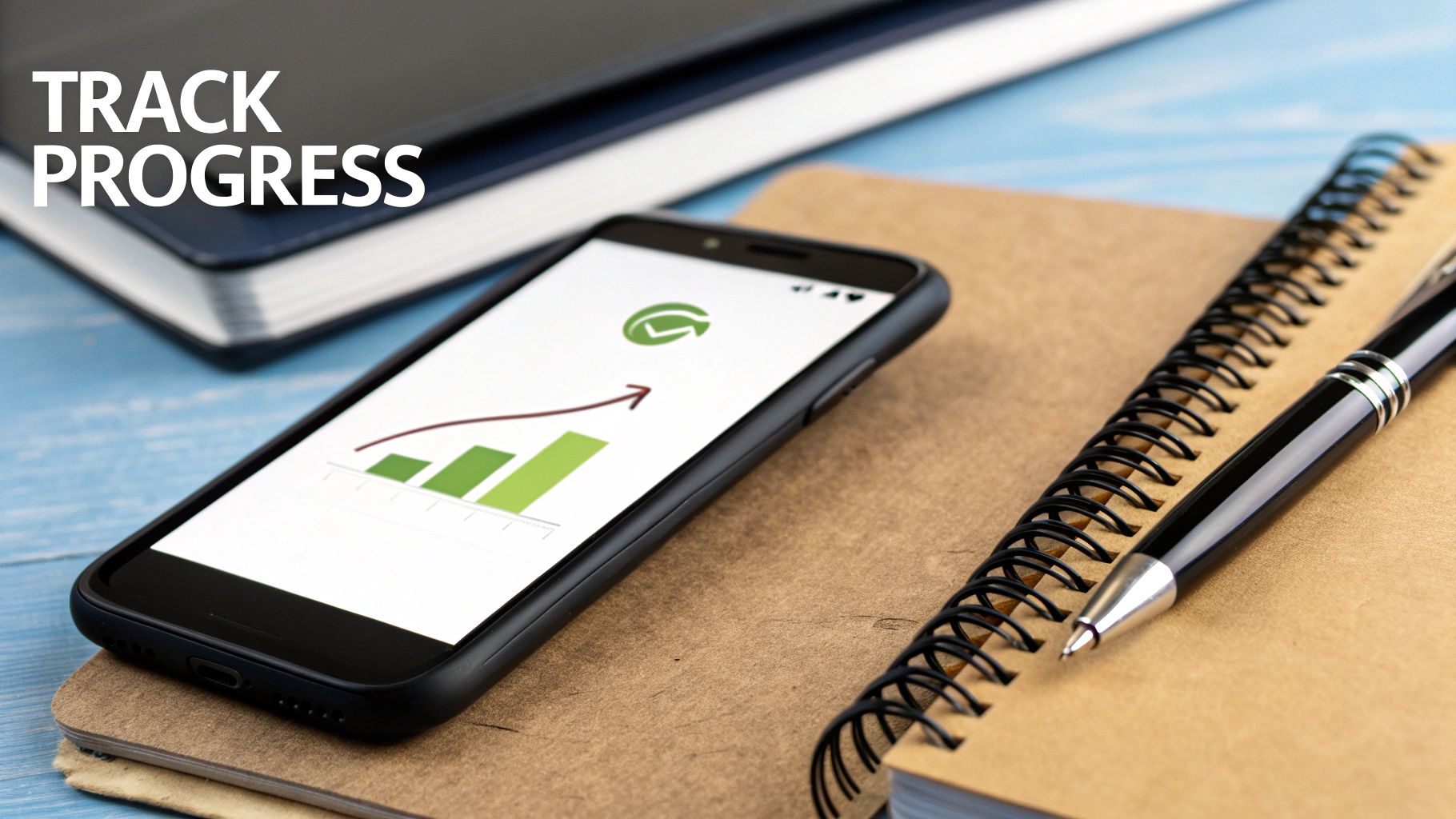
Let's be honest, trying to manually create, track, and tweak a meal plan can feel like a full-time job. Juggling macro calculations for every single ingredient and then trying to build a sensible grocery list is enough to make anyone want to give up.
Fortunately, you don’t have to do it all by yourself. Technology can be your most powerful ally here, taking on the heavy lifting so you can actually focus on seeing results.
The right digital tools can completely change how you approach your diet. They essentially take the guesswork out of the equation, making a personalized meal plan for weight loss more accessible and manageable than ever. Think of these apps as a pocket nutritionist, guide, and accountability partner, all rolled into one.
How Apps Automate Your Success
Modern meal planning apps are specifically designed to handle the most tedious parts of dieting. They offer a whole suite of features that streamline the entire process, from the initial plan all the way to your plate.
These tools are built around your unique data. You simply plug in your goals, dietary needs, and food preferences, and they generate a plan that actually fits your life.
Here are a few key features that really make a difference:
- Automated Meal Generation: Apps can instantly whip up a full week of meals that hit your specific calorie and macronutrient targets.
- Effortless Food Logging: Most have huge food databases and barcode scanners, which makes logging what you eat a matter of seconds.
- Smart Grocery Lists: Once your plan is set, the app can automatically create a shopping list with the exact ingredients you need. This saves a ton of time and helps you avoid those tempting impulse buys at the store.
- Progress Tracking: Seeing your progress in visual charts and data points is incredibly motivating and keeps you in the loop.
If you want a deeper look at how different applications can support you, it's worth checking out some recent fitness app tests.
Finding the Right Digital Tool for You
With so many options out there, picking the right app can feel a bit overwhelming. The best one for you really depends on your specific needs and even your personality. Some people thrive with strict guidance, while others need more flexibility to stay on track.
Ask yourself what you really need from a tool. Do you want an app that tells you exactly what to eat every single day? Or would you prefer one that helps you build your own meals while keeping an eye on your macros? Maybe you need features that can account for family members or specific restrictions like gluten-free or vegan diets.
The whole point of using technology is to reduce decision fatigue, not add another complicated task to your to-do list. The best app is always the one you will actually use consistently.
This approach is proving incredibly effective. Research shows that about 72% of users report improvements in both their physical and mental well-being after consistently using personalized meal planning apps.
On top of that, users noted a 60% increase in sticking to their nutrition goals and saved around three hours per week in meal-related stress. These tools are especially powerful for managing complex dietary needs, with some showing a 58% increase in users hitting their specific targets.
Making Technology Work in the Real World
Integrating an app into your daily routine is the final piece of the puzzle. Start by setting aside just a few minutes each day to log your meals. Then, find a bit of time on the weekend to review the plan for the upcoming week.
Think of it as a daily check-in with your goals. The insights you'll get are invaluable. You might discover you're consistently low on protein, or that a certain afternoon snack is what's pushing you over your calorie limit.
This data empowers you to make small, informed adjustments that lead to huge results over time. By letting technology handle the tedious calculations and planning, you free up your mental energy to focus on what truly matters: enjoying your food and celebrating your progress.
Got Questions About Meal Planning for Weight Loss? Let's Talk.
Jumping into a personalized meal plan is a huge first step, but let's be real—the real work starts when you try to fit that plan into your actual, busy life. That's when the questions pop up.
Don't worry, these are the same hurdles everyone faces. Let's walk through some of the most common ones so you can feel confident handling whatever comes your way.
"How Often Should I Tweak My Plan?"
This is a great question because it means you're already thinking about the long game. A meal plan should never be a rigid, set-in-stone document; it has to evolve as you do.
The most obvious sign it's time for a review is when your weight loss stalls for more than a couple of weeks. As you shed pounds, your body’s daily energy needs change—they actually decrease. That initial calorie deficit that worked so well can eventually become your new maintenance level.
As a general guideline, I tell people to take a fresh look at their numbers after every 10-15 pounds lost. This doesn't mean you have to scrap everything and start over. Usually, a small adjustment of about 100-150 calories per day is all it takes to kickstart progress again. The key is to make small, sustainable tweaks, not drastic cuts.
"What If I Have Dietary Restrictions?"
This is where a personalized plan really shines. Whether you're dealing with a gluten intolerance, dairy sensitivity, or follow a vegan lifestyle, the core principles don't change one bit. You still need to figure out your energy needs and balance your macros.
The only thing that changes is where you get your nutrients from.
- Going vegan? Your plan will be built on powerhouse plant proteins like lentils, tofu, tempeh, beans, and quinoa.
- Need to be gluten-free? You'll simply swap in carbs like rice, potatoes, certified gluten-free oats, and other grains.
The mindset shift is to focus on the abundance of foods you can enjoy, not on what's off-limits. Most modern meal planning apps even have filters for these specific needs, which makes finding delicious, compliant recipes easier than ever.
A personalized plan isn't about restriction; it's about mindful selection. It empowers you to build a healthy, satisfying diet within the framework of your specific needs, making long-term adherence possible.
"How Am I Supposed to Handle Eating Out?"
Life happens! Friends invite you to dinner, family comes to visit—and you shouldn't have to hide from it. The goal is to weave your healthy habits into your social life, not let them isolate you. The secret weapon here is simple: plan ahead.
Take two minutes to look up the restaurant's menu online before you go. Almost every place has one. You can spot the healthier options—like grilled proteins and steamed veggies—and decide what you'll order before you're even sitting at the table.
Another pro tip is to budget your calories for the day. If you know you have a big dinner planned, go for a lighter lunch. One single meal is never going to derail all your progress. The most important thing is to enjoy yourself, make a conscious choice, and then get right back to your plan with the very next meal.
"Do I Really Have to Spend All Sunday Meal Prepping?"
Nope. Absolutely not. Forget the images you've seen of a counter covered in dozens of identical plastic containers. That works for some people, but it's not the only way.
Effective meal prep is simply about doing what makes your week easier and helps you avoid decision fatigue when you're tired and hungry.
For many, this means just prepping a few key components.
- Batch-cook a protein: Grill up a few chicken breasts or bake a large piece of salmon. You can toss it into salads, wraps, or grain bowls all week.
- Chop your veggies: Having a container of pre-chopped onions, peppers, and broccoli makes a weeknight stir-fry come together in minutes.
- Portion out your snacks: Pre-fill small bags with nuts and seeds or portion out Greek yogurt into grab-and-go containers.
Find the level of prep that genuinely reduces your stress instead of adding to it. Honestly, even prepping for just two or three days at a time can be the difference between sticking to your plan and ordering last-minute takeout.
Ready to stop guessing and start seeing results? AI Meal Planner creates a fully customized meal plan based on your unique goals, tastes, and lifestyle. Let us do the planning so you can focus on living a healthier, happier life. Start your personalized plan today!
AI-powered nutrition
Get Your Personalized Meal Plan
AI creates the perfect meals for your goals, lifestyle, and taste.
Start Your Journej